Anatomy and Physiology Case Study: Analysis of Body Systems and Health
VerifiedAdded on 2023/06/05
|13
|3518
|169
Case Study
AI Summary
This case study in Anatomy and Physiology examines various physiological processes and their impact on health. It begins with an analysis of Brodie's health, identifying him as overweight and discussing related health risks like high blood pressure and cholesterol, proposing lifestyle changes and dietary modifications. The study then delves into cellular respiration, differentiating between aerobic and anaerobic processes in skeletal muscles. Oxygen transport mechanisms, including the role of hemoglobin, are explained. Furthermore, the case study explores the structure and function of neurons, including neurotransmission and action potentials. Finally, it investigates venous return mechanisms, focusing on the muscle pump system, the impact of respiratory activity, and the relationship between blood pressure and cardiac output. The study provides a comprehensive overview of key concepts in anatomy and physiology.
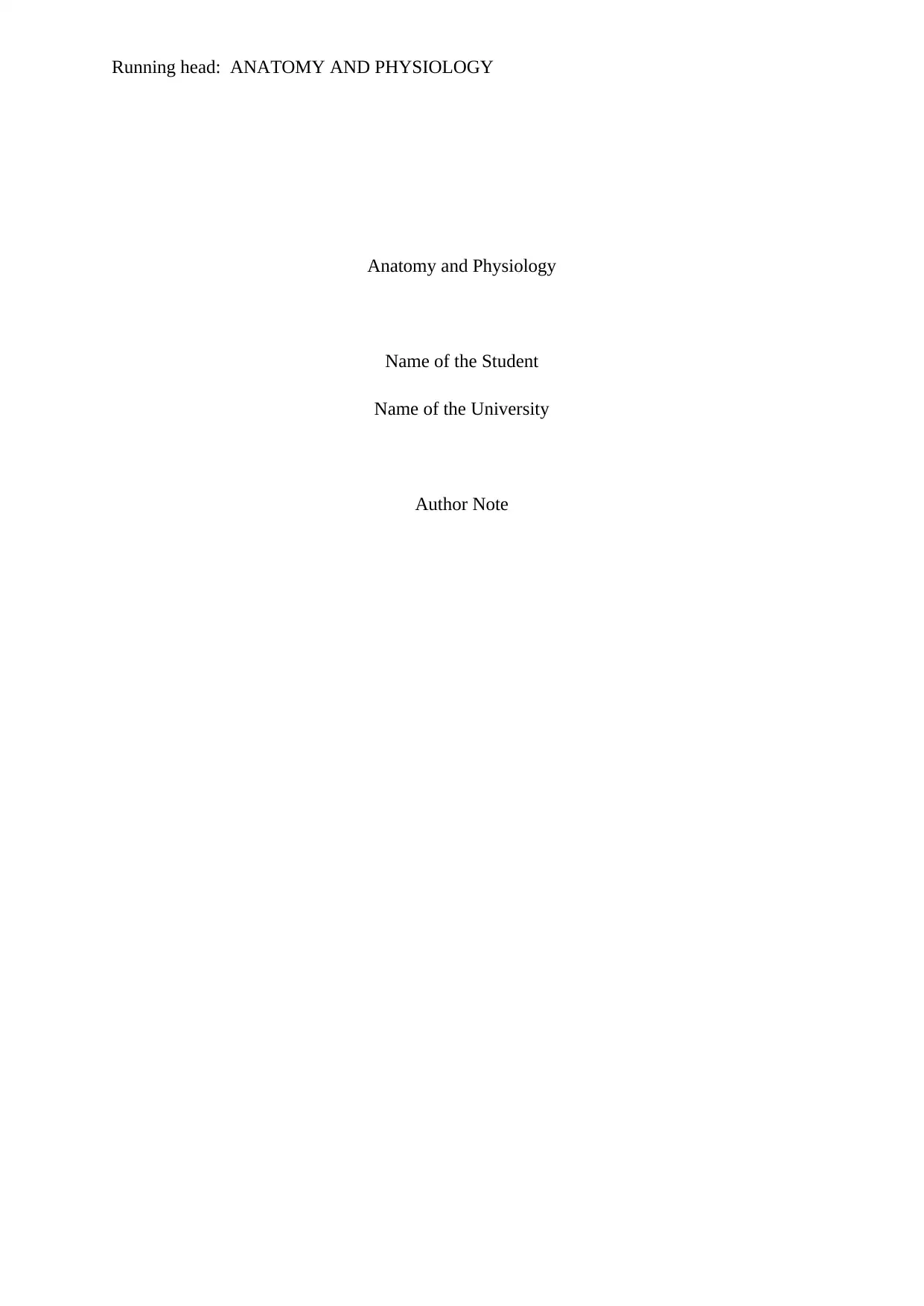
Running head: ANATOMY AND PHYSIOLOGY
Anatomy and Physiology
Name of the Student
Name of the University
Author Note
Anatomy and Physiology
Name of the Student
Name of the University
Author Note
Paraphrase This Document
Need a fresh take? Get an instant paraphrase of this document with our AI Paraphraser
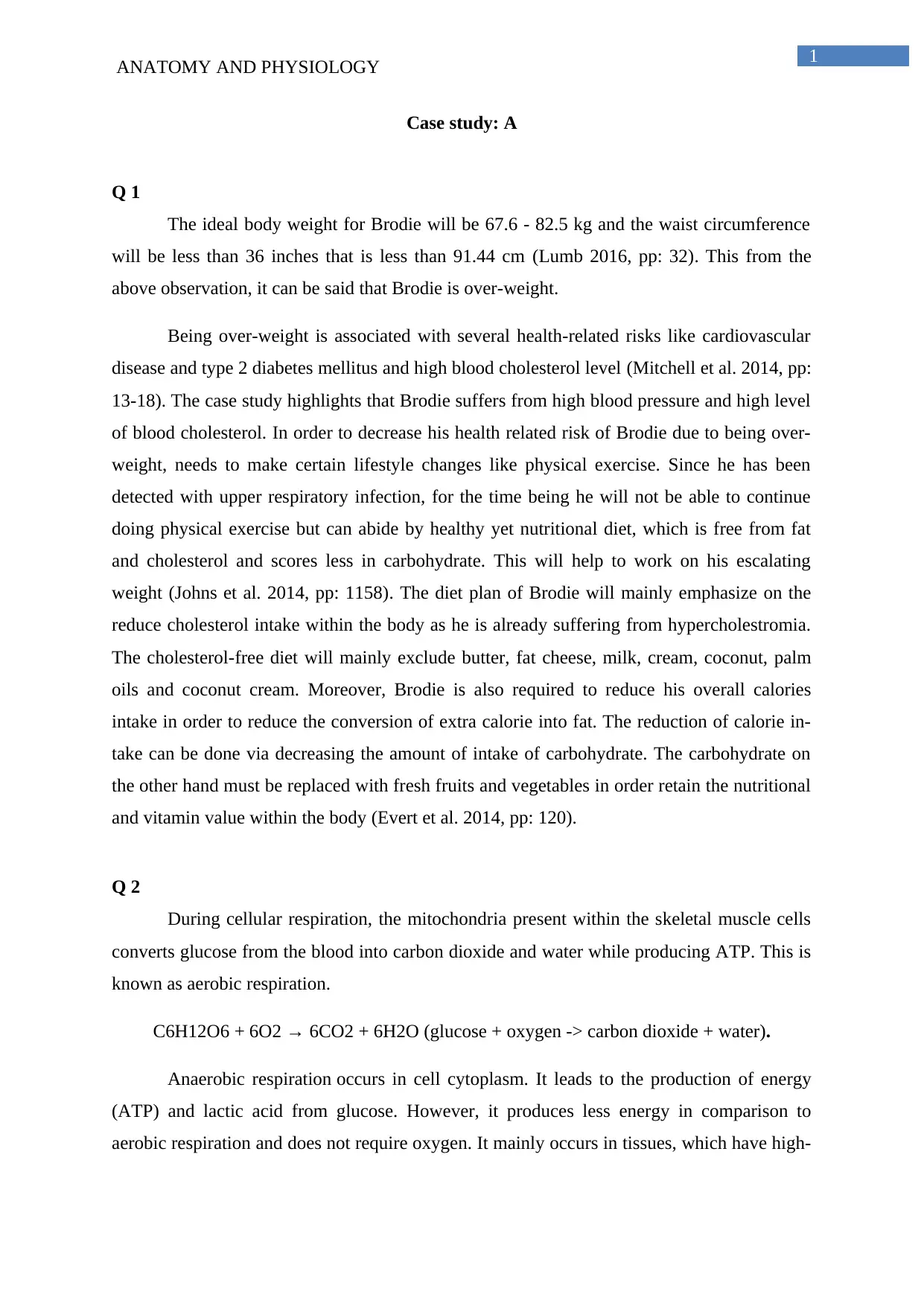
1
ANATOMY AND PHYSIOLOGY
Case study: A
Q 1
The ideal body weight for Brodie will be 67.6 - 82.5 kg and the waist circumference
will be less than 36 inches that is less than 91.44 cm (Lumb 2016, pp: 32). This from the
above observation, it can be said that Brodie is over-weight.
Being over-weight is associated with several health-related risks like cardiovascular
disease and type 2 diabetes mellitus and high blood cholesterol level (Mitchell et al. 2014, pp:
13-18). The case study highlights that Brodie suffers from high blood pressure and high level
of blood cholesterol. In order to decrease his health related risk of Brodie due to being over-
weight, needs to make certain lifestyle changes like physical exercise. Since he has been
detected with upper respiratory infection, for the time being he will not be able to continue
doing physical exercise but can abide by healthy yet nutritional diet, which is free from fat
and cholesterol and scores less in carbohydrate. This will help to work on his escalating
weight (Johns et al. 2014, pp: 1158). The diet plan of Brodie will mainly emphasize on the
reduce cholesterol intake within the body as he is already suffering from hypercholestromia.
The cholesterol-free diet will mainly exclude butter, fat cheese, milk, cream, coconut, palm
oils and coconut cream. Moreover, Brodie is also required to reduce his overall calories
intake in order to reduce the conversion of extra calorie into fat. The reduction of calorie in-
take can be done via decreasing the amount of intake of carbohydrate. The carbohydrate on
the other hand must be replaced with fresh fruits and vegetables in order retain the nutritional
and vitamin value within the body (Evert et al. 2014, pp: 120).
Q 2
During cellular respiration, the mitochondria present within the skeletal muscle cells
converts glucose from the blood into carbon dioxide and water while producing ATP. This is
known as aerobic respiration.
C6H12O6 + 6O2 → 6CO2 + 6H2O (glucose + oxygen -> carbon dioxide + water).
Anaerobic respiration occurs in cell cytoplasm. It leads to the production of energy
(ATP) and lactic acid from glucose. However, it produces less energy in comparison to
aerobic respiration and does not require oxygen. It mainly occurs in tissues, which have high-
ANATOMY AND PHYSIOLOGY
Case study: A
Q 1
The ideal body weight for Brodie will be 67.6 - 82.5 kg and the waist circumference
will be less than 36 inches that is less than 91.44 cm (Lumb 2016, pp: 32). This from the
above observation, it can be said that Brodie is over-weight.
Being over-weight is associated with several health-related risks like cardiovascular
disease and type 2 diabetes mellitus and high blood cholesterol level (Mitchell et al. 2014, pp:
13-18). The case study highlights that Brodie suffers from high blood pressure and high level
of blood cholesterol. In order to decrease his health related risk of Brodie due to being over-
weight, needs to make certain lifestyle changes like physical exercise. Since he has been
detected with upper respiratory infection, for the time being he will not be able to continue
doing physical exercise but can abide by healthy yet nutritional diet, which is free from fat
and cholesterol and scores less in carbohydrate. This will help to work on his escalating
weight (Johns et al. 2014, pp: 1158). The diet plan of Brodie will mainly emphasize on the
reduce cholesterol intake within the body as he is already suffering from hypercholestromia.
The cholesterol-free diet will mainly exclude butter, fat cheese, milk, cream, coconut, palm
oils and coconut cream. Moreover, Brodie is also required to reduce his overall calories
intake in order to reduce the conversion of extra calorie into fat. The reduction of calorie in-
take can be done via decreasing the amount of intake of carbohydrate. The carbohydrate on
the other hand must be replaced with fresh fruits and vegetables in order retain the nutritional
and vitamin value within the body (Evert et al. 2014, pp: 120).
Q 2
During cellular respiration, the mitochondria present within the skeletal muscle cells
converts glucose from the blood into carbon dioxide and water while producing ATP. This is
known as aerobic respiration.
C6H12O6 + 6O2 → 6CO2 + 6H2O (glucose + oxygen -> carbon dioxide + water).
Anaerobic respiration occurs in cell cytoplasm. It leads to the production of energy
(ATP) and lactic acid from glucose. However, it produces less energy in comparison to
aerobic respiration and does not require oxygen. It mainly occurs in tissues, which have high-
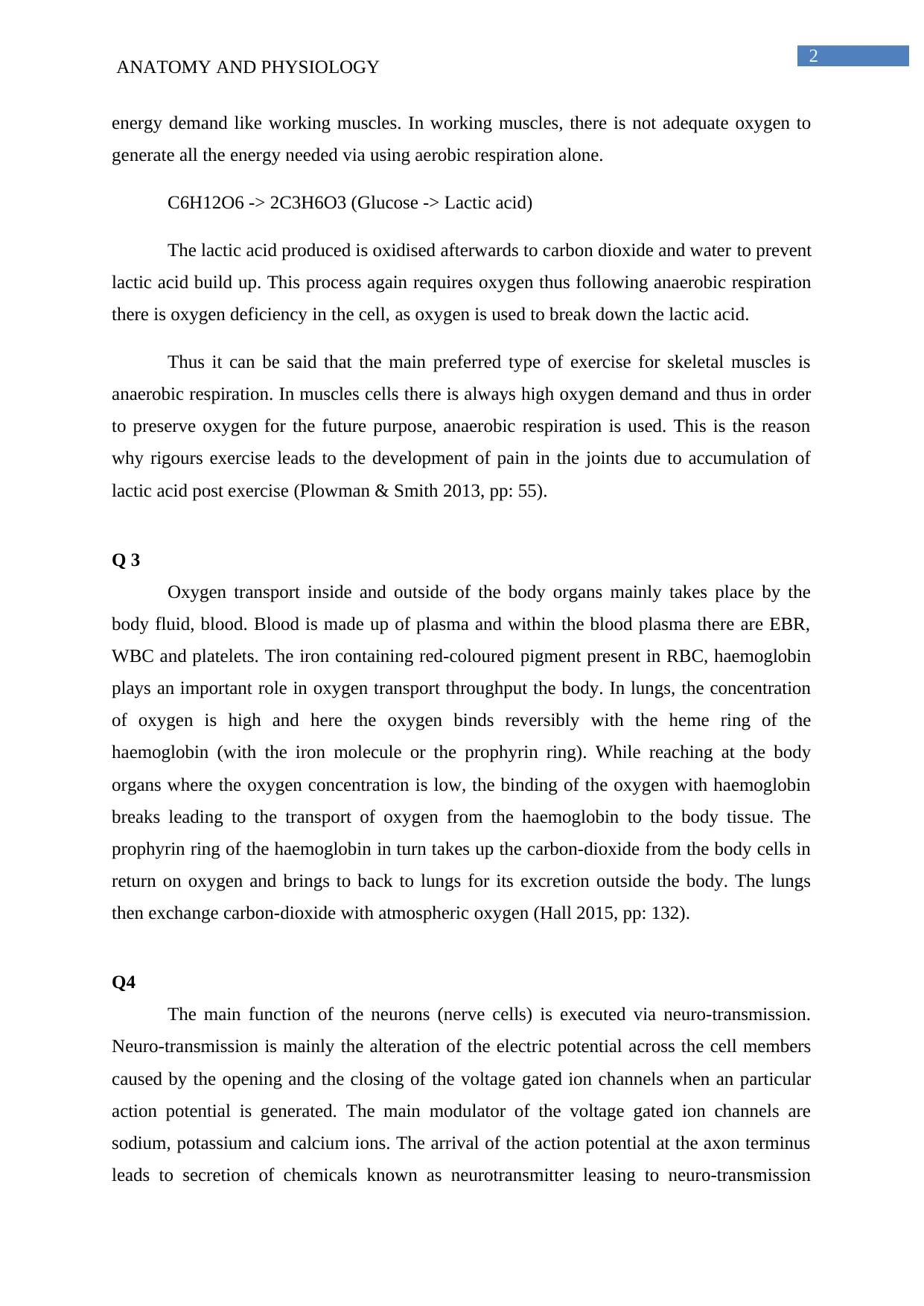
2
ANATOMY AND PHYSIOLOGY
energy demand like working muscles. In working muscles, there is not adequate oxygen to
generate all the energy needed via using aerobic respiration alone.
C6H12O6 -> 2C3H6O3 (Glucose -> Lactic acid)
The lactic acid produced is oxidised afterwards to carbon dioxide and water to prevent
lactic acid build up. This process again requires oxygen thus following anaerobic respiration
there is oxygen deficiency in the cell, as oxygen is used to break down the lactic acid.
Thus it can be said that the main preferred type of exercise for skeletal muscles is
anaerobic respiration. In muscles cells there is always high oxygen demand and thus in order
to preserve oxygen for the future purpose, anaerobic respiration is used. This is the reason
why rigours exercise leads to the development of pain in the joints due to accumulation of
lactic acid post exercise (Plowman & Smith 2013, pp: 55).
Q 3
Oxygen transport inside and outside of the body organs mainly takes place by the
body fluid, blood. Blood is made up of plasma and within the blood plasma there are EBR,
WBC and platelets. The iron containing red-coloured pigment present in RBC, haemoglobin
plays an important role in oxygen transport throughput the body. In lungs, the concentration
of oxygen is high and here the oxygen binds reversibly with the heme ring of the
haemoglobin (with the iron molecule or the prophyrin ring). While reaching at the body
organs where the oxygen concentration is low, the binding of the oxygen with haemoglobin
breaks leading to the transport of oxygen from the haemoglobin to the body tissue. The
prophyrin ring of the haemoglobin in turn takes up the carbon-dioxide from the body cells in
return on oxygen and brings to back to lungs for its excretion outside the body. The lungs
then exchange carbon-dioxide with atmospheric oxygen (Hall 2015, pp: 132).
Q4
The main function of the neurons (nerve cells) is executed via neuro-transmission.
Neuro-transmission is mainly the alteration of the electric potential across the cell members
caused by the opening and the closing of the voltage gated ion channels when an particular
action potential is generated. The main modulator of the voltage gated ion channels are
sodium, potassium and calcium ions. The arrival of the action potential at the axon terminus
leads to secretion of chemicals known as neurotransmitter leasing to neuro-transmission
ANATOMY AND PHYSIOLOGY
energy demand like working muscles. In working muscles, there is not adequate oxygen to
generate all the energy needed via using aerobic respiration alone.
C6H12O6 -> 2C3H6O3 (Glucose -> Lactic acid)
The lactic acid produced is oxidised afterwards to carbon dioxide and water to prevent
lactic acid build up. This process again requires oxygen thus following anaerobic respiration
there is oxygen deficiency in the cell, as oxygen is used to break down the lactic acid.
Thus it can be said that the main preferred type of exercise for skeletal muscles is
anaerobic respiration. In muscles cells there is always high oxygen demand and thus in order
to preserve oxygen for the future purpose, anaerobic respiration is used. This is the reason
why rigours exercise leads to the development of pain in the joints due to accumulation of
lactic acid post exercise (Plowman & Smith 2013, pp: 55).
Q 3
Oxygen transport inside and outside of the body organs mainly takes place by the
body fluid, blood. Blood is made up of plasma and within the blood plasma there are EBR,
WBC and platelets. The iron containing red-coloured pigment present in RBC, haemoglobin
plays an important role in oxygen transport throughput the body. In lungs, the concentration
of oxygen is high and here the oxygen binds reversibly with the heme ring of the
haemoglobin (with the iron molecule or the prophyrin ring). While reaching at the body
organs where the oxygen concentration is low, the binding of the oxygen with haemoglobin
breaks leading to the transport of oxygen from the haemoglobin to the body tissue. The
prophyrin ring of the haemoglobin in turn takes up the carbon-dioxide from the body cells in
return on oxygen and brings to back to lungs for its excretion outside the body. The lungs
then exchange carbon-dioxide with atmospheric oxygen (Hall 2015, pp: 132).
Q4
The main function of the neurons (nerve cells) is executed via neuro-transmission.
Neuro-transmission is mainly the alteration of the electric potential across the cell members
caused by the opening and the closing of the voltage gated ion channels when an particular
action potential is generated. The main modulator of the voltage gated ion channels are
sodium, potassium and calcium ions. The arrival of the action potential at the axon terminus
leads to secretion of chemicals known as neurotransmitter leasing to neuro-transmission
⊘ This is a preview!⊘
Do you want full access?
Subscribe today to unlock all pages.

Trusted by 1+ million students worldwide
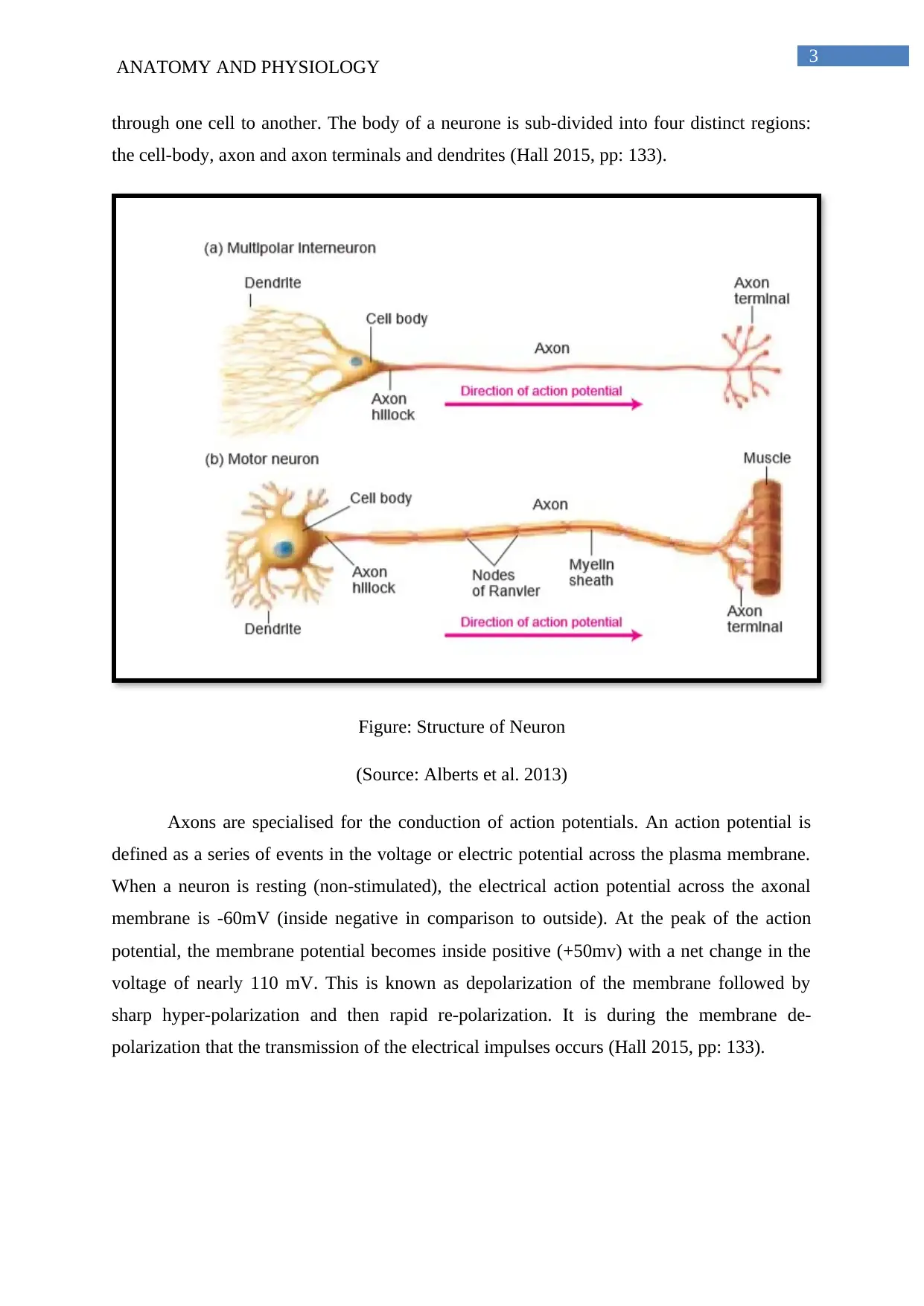
3
ANATOMY AND PHYSIOLOGY
through one cell to another. The body of a neurone is sub-divided into four distinct regions:
the cell-body, axon and axon terminals and dendrites (Hall 2015, pp: 133).
Figure: Structure of Neuron
(Source: Alberts et al. 2013)
Axons are specialised for the conduction of action potentials. An action potential is
defined as a series of events in the voltage or electric potential across the plasma membrane.
When a neuron is resting (non-stimulated), the electrical action potential across the axonal
membrane is -60mV (inside negative in comparison to outside). At the peak of the action
potential, the membrane potential becomes inside positive (+50mv) with a net change in the
voltage of nearly 110 mV. This is known as depolarization of the membrane followed by
sharp hyper-polarization and then rapid re-polarization. It is during the membrane de-
polarization that the transmission of the electrical impulses occurs (Hall 2015, pp: 133).
ANATOMY AND PHYSIOLOGY
through one cell to another. The body of a neurone is sub-divided into four distinct regions:
the cell-body, axon and axon terminals and dendrites (Hall 2015, pp: 133).
Figure: Structure of Neuron
(Source: Alberts et al. 2013)
Axons are specialised for the conduction of action potentials. An action potential is
defined as a series of events in the voltage or electric potential across the plasma membrane.
When a neuron is resting (non-stimulated), the electrical action potential across the axonal
membrane is -60mV (inside negative in comparison to outside). At the peak of the action
potential, the membrane potential becomes inside positive (+50mv) with a net change in the
voltage of nearly 110 mV. This is known as depolarization of the membrane followed by
sharp hyper-polarization and then rapid re-polarization. It is during the membrane de-
polarization that the transmission of the electrical impulses occurs (Hall 2015, pp: 133).
Paraphrase This Document
Need a fresh take? Get an instant paraphrase of this document with our AI Paraphraser
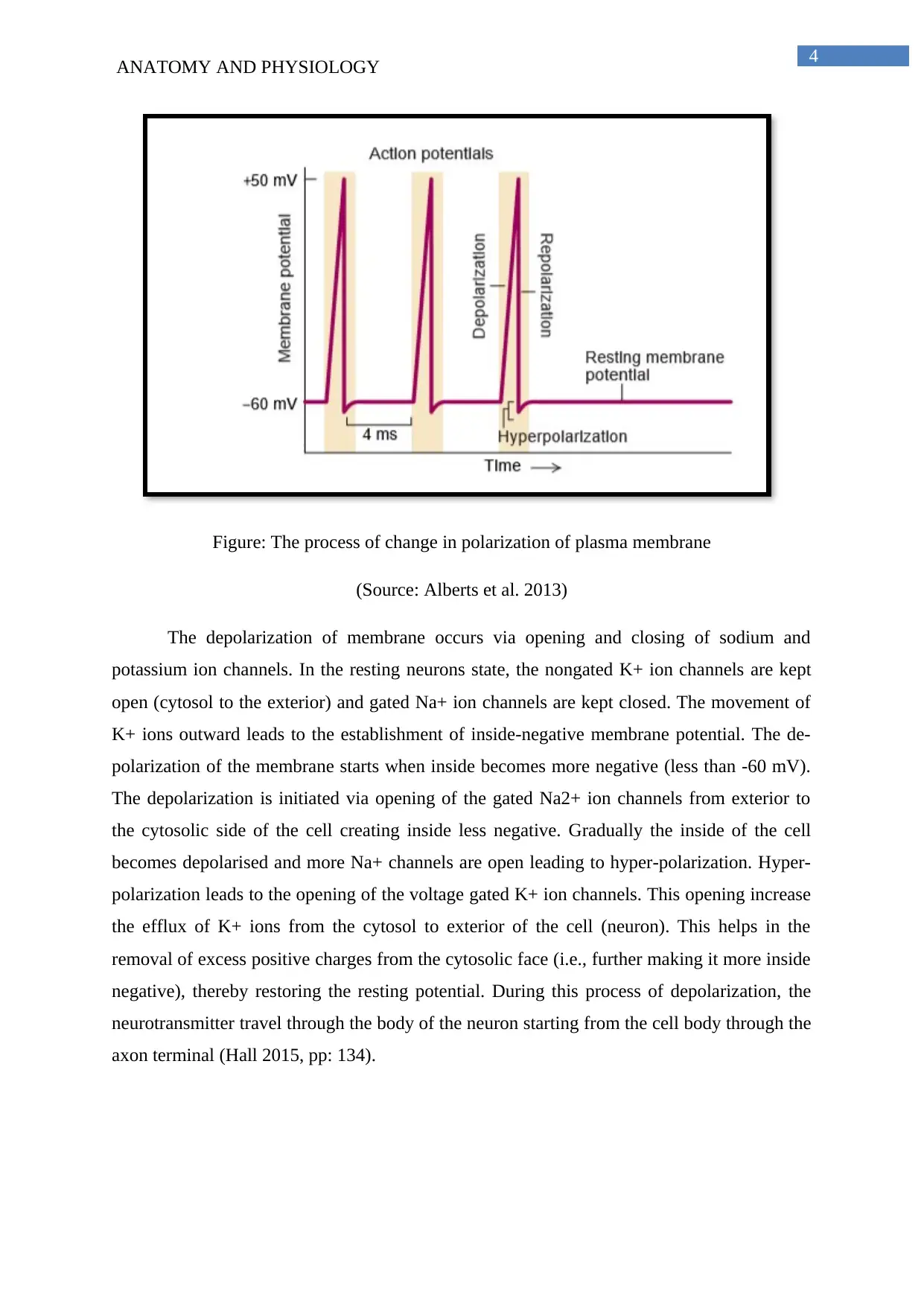
4
ANATOMY AND PHYSIOLOGY
Figure: The process of change in polarization of plasma membrane
(Source: Alberts et al. 2013)
The depolarization of membrane occurs via opening and closing of sodium and
potassium ion channels. In the resting neurons state, the nongated K+ ion channels are kept
open (cytosol to the exterior) and gated Na+ ion channels are kept closed. The movement of
K+ ions outward leads to the establishment of inside-negative membrane potential. The de-
polarization of the membrane starts when inside becomes more negative (less than -60 mV).
The depolarization is initiated via opening of the gated Na2+ ion channels from exterior to
the cytosolic side of the cell creating inside less negative. Gradually the inside of the cell
becomes depolarised and more Na+ channels are open leading to hyper-polarization. Hyper-
polarization leads to the opening of the voltage gated K+ ion channels. This opening increase
the efflux of K+ ions from the cytosol to exterior of the cell (neuron). This helps in the
removal of excess positive charges from the cytosolic face (i.e., further making it more inside
negative), thereby restoring the resting potential. During this process of depolarization, the
neurotransmitter travel through the body of the neuron starting from the cell body through the
axon terminal (Hall 2015, pp: 134).
ANATOMY AND PHYSIOLOGY
Figure: The process of change in polarization of plasma membrane
(Source: Alberts et al. 2013)
The depolarization of membrane occurs via opening and closing of sodium and
potassium ion channels. In the resting neurons state, the nongated K+ ion channels are kept
open (cytosol to the exterior) and gated Na+ ion channels are kept closed. The movement of
K+ ions outward leads to the establishment of inside-negative membrane potential. The de-
polarization of the membrane starts when inside becomes more negative (less than -60 mV).
The depolarization is initiated via opening of the gated Na2+ ion channels from exterior to
the cytosolic side of the cell creating inside less negative. Gradually the inside of the cell
becomes depolarised and more Na+ channels are open leading to hyper-polarization. Hyper-
polarization leads to the opening of the voltage gated K+ ion channels. This opening increase
the efflux of K+ ions from the cytosol to exterior of the cell (neuron). This helps in the
removal of excess positive charges from the cytosolic face (i.e., further making it more inside
negative), thereby restoring the resting potential. During this process of depolarization, the
neurotransmitter travel through the body of the neuron starting from the cell body through the
axon terminal (Hall 2015, pp: 134).
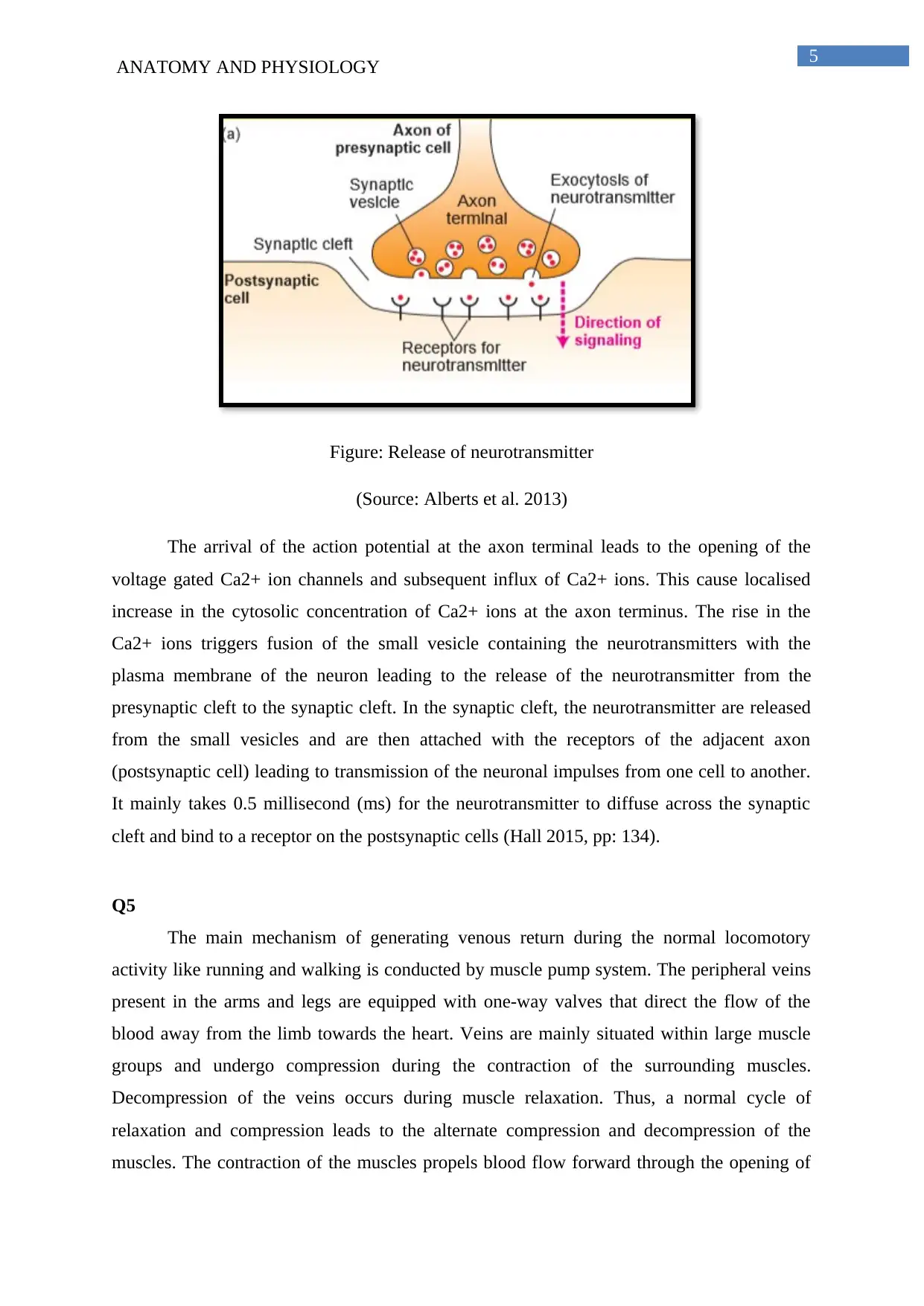
5
ANATOMY AND PHYSIOLOGY
Figure: Release of neurotransmitter
(Source: Alberts et al. 2013)
The arrival of the action potential at the axon terminal leads to the opening of the
voltage gated Ca2+ ion channels and subsequent influx of Ca2+ ions. This cause localised
increase in the cytosolic concentration of Ca2+ ions at the axon terminus. The rise in the
Ca2+ ions triggers fusion of the small vesicle containing the neurotransmitters with the
plasma membrane of the neuron leading to the release of the neurotransmitter from the
presynaptic cleft to the synaptic cleft. In the synaptic cleft, the neurotransmitter are released
from the small vesicles and are then attached with the receptors of the adjacent axon
(postsynaptic cell) leading to transmission of the neuronal impulses from one cell to another.
It mainly takes 0.5 millisecond (ms) for the neurotransmitter to diffuse across the synaptic
cleft and bind to a receptor on the postsynaptic cells (Hall 2015, pp: 134).
Q5
The main mechanism of generating venous return during the normal locomotory
activity like running and walking is conducted by muscle pump system. The peripheral veins
present in the arms and legs are equipped with one-way valves that direct the flow of the
blood away from the limb towards the heart. Veins are mainly situated within large muscle
groups and undergo compression during the contraction of the surrounding muscles.
Decompression of the veins occurs during muscle relaxation. Thus, a normal cycle of
relaxation and compression leads to the alternate compression and decompression of the
muscles. The contraction of the muscles propels blood flow forward through the opening of
ANATOMY AND PHYSIOLOGY
Figure: Release of neurotransmitter
(Source: Alberts et al. 2013)
The arrival of the action potential at the axon terminal leads to the opening of the
voltage gated Ca2+ ion channels and subsequent influx of Ca2+ ions. This cause localised
increase in the cytosolic concentration of Ca2+ ions at the axon terminus. The rise in the
Ca2+ ions triggers fusion of the small vesicle containing the neurotransmitters with the
plasma membrane of the neuron leading to the release of the neurotransmitter from the
presynaptic cleft to the synaptic cleft. In the synaptic cleft, the neurotransmitter are released
from the small vesicles and are then attached with the receptors of the adjacent axon
(postsynaptic cell) leading to transmission of the neuronal impulses from one cell to another.
It mainly takes 0.5 millisecond (ms) for the neurotransmitter to diffuse across the synaptic
cleft and bind to a receptor on the postsynaptic cells (Hall 2015, pp: 134).
Q5
The main mechanism of generating venous return during the normal locomotory
activity like running and walking is conducted by muscle pump system. The peripheral veins
present in the arms and legs are equipped with one-way valves that direct the flow of the
blood away from the limb towards the heart. Veins are mainly situated within large muscle
groups and undergo compression during the contraction of the surrounding muscles.
Decompression of the veins occurs during muscle relaxation. Thus, a normal cycle of
relaxation and compression leads to the alternate compression and decompression of the
muscles. The contraction of the muscles propels blood flow forward through the opening of
⊘ This is a preview!⊘
Do you want full access?
Subscribe today to unlock all pages.

Trusted by 1+ million students worldwide

6
ANATOMY AND PHYSIOLOGY
distal valves and then impedes the flow into the muscles via the closure of the proximal
valves during the process of contraction. During muscle relaxation, the proximal valves open
and the filling of the venous segment occurs via the flow of the blood. During the initial
stages of relaxation, the distal valves close but then they open in response of the increased
blood volume and blood pressure in the venous segment. The overall effect of the cycle of
compression and relaxation propels the flow of the blood towards the direction of the heart.
The venous valves prevent the blood from flowing backwards and thus enabling
unidirectional flow that increases the process of venous return (Berlin & Bakker 2014, pp:
1565).
Physical exercise leads to an increase of the respiratory activity. This respiratory
activity cast a significant impact on the venous return of the hart. Increasing and rate of
respiration as occurring during the process of physical exercise, there occurs increase the
venous return and thereby increasing the cardiac output. Non-typical respiratory activity like
increase in the rate of respiration arising out of cold and cough like closed glottis or forced
expiration reduces venous return and thereby leading to a decrease in the cardiac output
(Berlin & Bakker 2014, pp: 1565). The respiratory activity affects the overall venous return
via causing change in the atrial pressure. Increase in the right atrial pressure impedes the
overall venous return while decreasing this pressure promotes venous return. Respiratory
activity also leads to the change in the diameter of the thoracic vena cava and cardiac
chambers which either directly or indirectly affect the venous return (Berlin & Bakker 2014,
pp: 1565).
Systemic arterial blood pressure of Brodie is 150/95mmHg. This is higher than the
normal range as the normal systemic arterial blood pressure is <120/<80 mmHg. Increase in
the blood pressure leads to an overall increase in the cardiac output which leads to an increase
in the venous return. This is because; venous return is defined as the flow of blood from the
periphery back to the right atrium (Berlin & Bakker 2014, pp: 1565). It is continues for few
seconds and is equal to cardiac output. However, it is also stated that the significance of the
statement, "cardiac output is controlled by venous return" is, it is not the heart itself that is the
primary controller of cardiac output. The associated peripheral circulation affect the flow of
the blood into the heart from the veins and these are the primary controllers of venous return
(Berlin & Bakker 2014, pp: 1565).
Q6
ANATOMY AND PHYSIOLOGY
distal valves and then impedes the flow into the muscles via the closure of the proximal
valves during the process of contraction. During muscle relaxation, the proximal valves open
and the filling of the venous segment occurs via the flow of the blood. During the initial
stages of relaxation, the distal valves close but then they open in response of the increased
blood volume and blood pressure in the venous segment. The overall effect of the cycle of
compression and relaxation propels the flow of the blood towards the direction of the heart.
The venous valves prevent the blood from flowing backwards and thus enabling
unidirectional flow that increases the process of venous return (Berlin & Bakker 2014, pp:
1565).
Physical exercise leads to an increase of the respiratory activity. This respiratory
activity cast a significant impact on the venous return of the hart. Increasing and rate of
respiration as occurring during the process of physical exercise, there occurs increase the
venous return and thereby increasing the cardiac output. Non-typical respiratory activity like
increase in the rate of respiration arising out of cold and cough like closed glottis or forced
expiration reduces venous return and thereby leading to a decrease in the cardiac output
(Berlin & Bakker 2014, pp: 1565). The respiratory activity affects the overall venous return
via causing change in the atrial pressure. Increase in the right atrial pressure impedes the
overall venous return while decreasing this pressure promotes venous return. Respiratory
activity also leads to the change in the diameter of the thoracic vena cava and cardiac
chambers which either directly or indirectly affect the venous return (Berlin & Bakker 2014,
pp: 1565).
Systemic arterial blood pressure of Brodie is 150/95mmHg. This is higher than the
normal range as the normal systemic arterial blood pressure is <120/<80 mmHg. Increase in
the blood pressure leads to an overall increase in the cardiac output which leads to an increase
in the venous return. This is because; venous return is defined as the flow of blood from the
periphery back to the right atrium (Berlin & Bakker 2014, pp: 1565). It is continues for few
seconds and is equal to cardiac output. However, it is also stated that the significance of the
statement, "cardiac output is controlled by venous return" is, it is not the heart itself that is the
primary controller of cardiac output. The associated peripheral circulation affect the flow of
the blood into the heart from the veins and these are the primary controllers of venous return
(Berlin & Bakker 2014, pp: 1565).
Q6
Paraphrase This Document
Need a fresh take? Get an instant paraphrase of this document with our AI Paraphraser
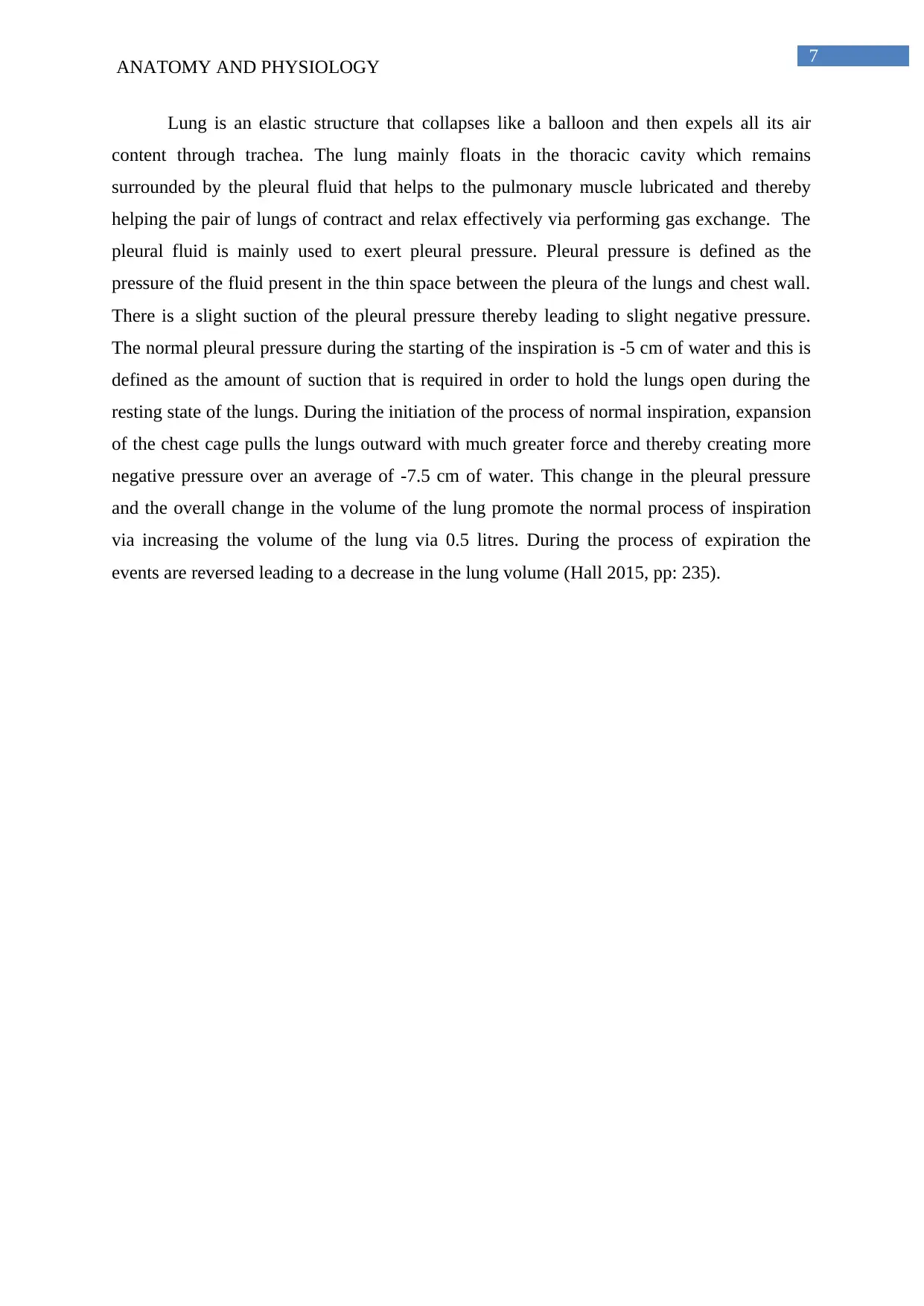
7
ANATOMY AND PHYSIOLOGY
Lung is an elastic structure that collapses like a balloon and then expels all its air
content through trachea. The lung mainly floats in the thoracic cavity which remains
surrounded by the pleural fluid that helps to the pulmonary muscle lubricated and thereby
helping the pair of lungs of contract and relax effectively via performing gas exchange. The
pleural fluid is mainly used to exert pleural pressure. Pleural pressure is defined as the
pressure of the fluid present in the thin space between the pleura of the lungs and chest wall.
There is a slight suction of the pleural pressure thereby leading to slight negative pressure.
The normal pleural pressure during the starting of the inspiration is -5 cm of water and this is
defined as the amount of suction that is required in order to hold the lungs open during the
resting state of the lungs. During the initiation of the process of normal inspiration, expansion
of the chest cage pulls the lungs outward with much greater force and thereby creating more
negative pressure over an average of -7.5 cm of water. This change in the pleural pressure
and the overall change in the volume of the lung promote the normal process of inspiration
via increasing the volume of the lung via 0.5 litres. During the process of expiration the
events are reversed leading to a decrease in the lung volume (Hall 2015, pp: 235).
ANATOMY AND PHYSIOLOGY
Lung is an elastic structure that collapses like a balloon and then expels all its air
content through trachea. The lung mainly floats in the thoracic cavity which remains
surrounded by the pleural fluid that helps to the pulmonary muscle lubricated and thereby
helping the pair of lungs of contract and relax effectively via performing gas exchange. The
pleural fluid is mainly used to exert pleural pressure. Pleural pressure is defined as the
pressure of the fluid present in the thin space between the pleura of the lungs and chest wall.
There is a slight suction of the pleural pressure thereby leading to slight negative pressure.
The normal pleural pressure during the starting of the inspiration is -5 cm of water and this is
defined as the amount of suction that is required in order to hold the lungs open during the
resting state of the lungs. During the initiation of the process of normal inspiration, expansion
of the chest cage pulls the lungs outward with much greater force and thereby creating more
negative pressure over an average of -7.5 cm of water. This change in the pleural pressure
and the overall change in the volume of the lung promote the normal process of inspiration
via increasing the volume of the lung via 0.5 litres. During the process of expiration the
events are reversed leading to a decrease in the lung volume (Hall 2015, pp: 235).

8
ANATOMY AND PHYSIOLOGY
Figure: Change in the lung volume in response to pleural pressure, transpulmonary pressure
and alveolar pressure
(Source: Hall 2015, pp: 235)
ANATOMY AND PHYSIOLOGY
Figure: Change in the lung volume in response to pleural pressure, transpulmonary pressure
and alveolar pressure
(Source: Hall 2015, pp: 235)
⊘ This is a preview!⊘
Do you want full access?
Subscribe today to unlock all pages.

Trusted by 1+ million students worldwide

9
ANATOMY AND PHYSIOLOGY
Figure: Process of contraction and relaxation of lungs
(Source: Hall 2015, pp: 235)
Brodie is suffering from mild upper respiratory tract infection. The effect of the upper
respiratory tract infection leads to the overall change in the pleural fluid due to inflammation.
Change in the pleural pressure hampers the contraction and relaxation of the pulmonary
muscles of the lungs. This alters the expansion and contraction of the lung muscle. As a result
the oxygen transfer from the lungs does not occur adequately leading to a decrease in the
overall oxygenation or the level of oxygen saturation within the body (Hall 2015, pp: 235).
The homeostasis during “cold” is usually maintained by hypothalamus of the brain.
The hypothalamus of the brain senses that the body is too cold than the required body
temperature. Then the hypothalamus of the brain sends signals to the muscle cells to increase
the temperature of the body. The muscle cells then executes the order of the brain via
increasing the shiver and creating warmth of the body. Increasing the warmth of the body
leads to fever. The hypothalamus also regulates the blood pressure in order to regulate the
body temperature and thereby maintaining homeostasis (Kander et al. 2015, pp: 27).
Q. 7
Coronary Heart Disease (CHD) or Coronary Artery Disease (CAD) is defined as a
pathological condition which is defined as an impaired flow of the blood to the arteries which
are responsible for supplying blood to the different parts of the heart. Thus it can be seen that
in CHD there occurs impaired blood flow in the arteries. This lack of proper circulation of the
ANATOMY AND PHYSIOLOGY
Figure: Process of contraction and relaxation of lungs
(Source: Hall 2015, pp: 235)
Brodie is suffering from mild upper respiratory tract infection. The effect of the upper
respiratory tract infection leads to the overall change in the pleural fluid due to inflammation.
Change in the pleural pressure hampers the contraction and relaxation of the pulmonary
muscles of the lungs. This alters the expansion and contraction of the lung muscle. As a result
the oxygen transfer from the lungs does not occur adequately leading to a decrease in the
overall oxygenation or the level of oxygen saturation within the body (Hall 2015, pp: 235).
The homeostasis during “cold” is usually maintained by hypothalamus of the brain.
The hypothalamus of the brain senses that the body is too cold than the required body
temperature. Then the hypothalamus of the brain sends signals to the muscle cells to increase
the temperature of the body. The muscle cells then executes the order of the brain via
increasing the shiver and creating warmth of the body. Increasing the warmth of the body
leads to fever. The hypothalamus also regulates the blood pressure in order to regulate the
body temperature and thereby maintaining homeostasis (Kander et al. 2015, pp: 27).
Q. 7
Coronary Heart Disease (CHD) or Coronary Artery Disease (CAD) is defined as a
pathological condition which is defined as an impaired flow of the blood to the arteries which
are responsible for supplying blood to the different parts of the heart. Thus it can be seen that
in CHD there occurs impaired blood flow in the arteries. This lack of proper circulation of the
Paraphrase This Document
Need a fresh take? Get an instant paraphrase of this document with our AI Paraphraser
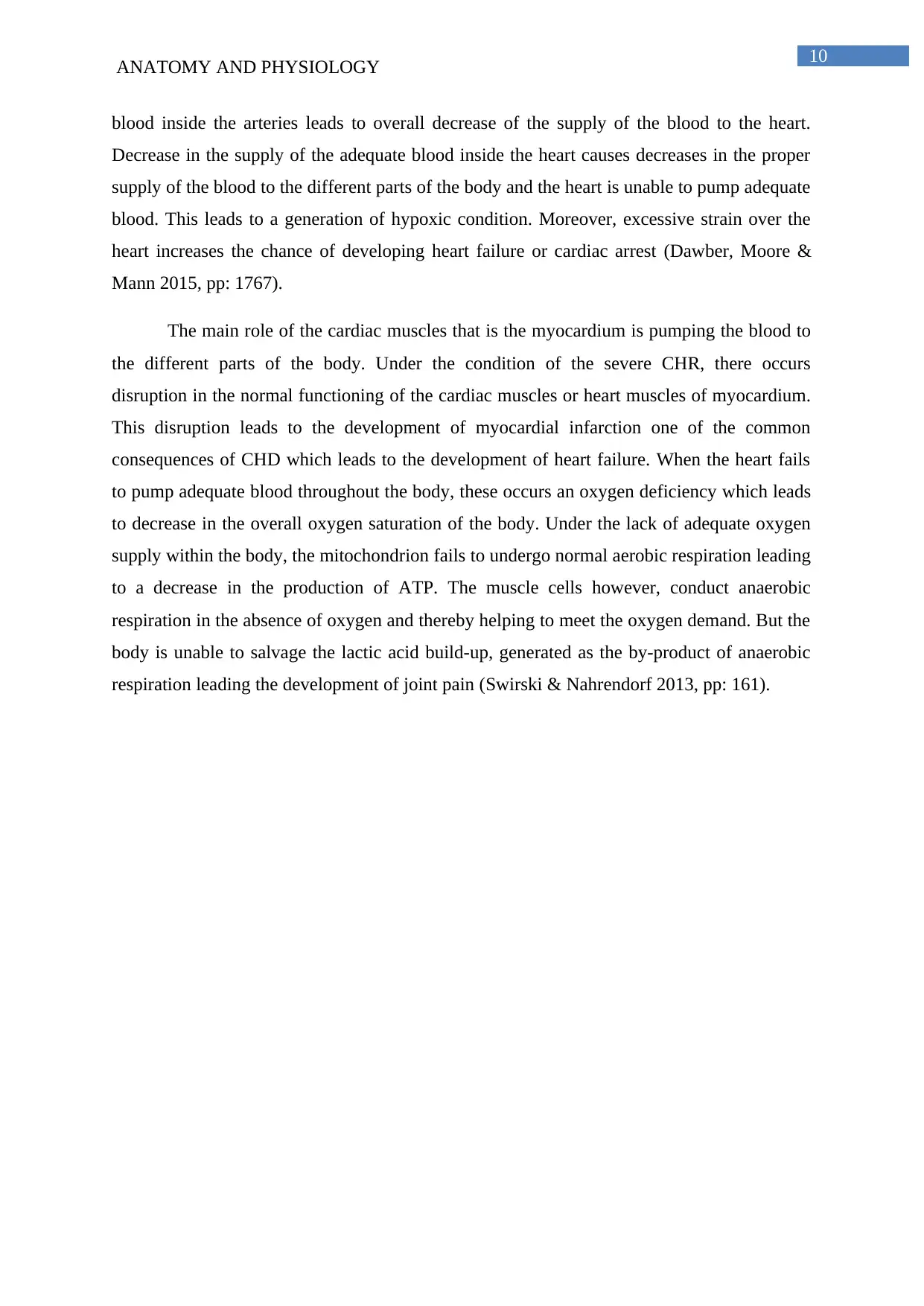
10
ANATOMY AND PHYSIOLOGY
blood inside the arteries leads to overall decrease of the supply of the blood to the heart.
Decrease in the supply of the adequate blood inside the heart causes decreases in the proper
supply of the blood to the different parts of the body and the heart is unable to pump adequate
blood. This leads to a generation of hypoxic condition. Moreover, excessive strain over the
heart increases the chance of developing heart failure or cardiac arrest (Dawber, Moore &
Mann 2015, pp: 1767).
The main role of the cardiac muscles that is the myocardium is pumping the blood to
the different parts of the body. Under the condition of the severe CHR, there occurs
disruption in the normal functioning of the cardiac muscles or heart muscles of myocardium.
This disruption leads to the development of myocardial infarction one of the common
consequences of CHD which leads to the development of heart failure. When the heart fails
to pump adequate blood throughout the body, these occurs an oxygen deficiency which leads
to decrease in the overall oxygen saturation of the body. Under the lack of adequate oxygen
supply within the body, the mitochondrion fails to undergo normal aerobic respiration leading
to a decrease in the production of ATP. The muscle cells however, conduct anaerobic
respiration in the absence of oxygen and thereby helping to meet the oxygen demand. But the
body is unable to salvage the lactic acid build-up, generated as the by-product of anaerobic
respiration leading the development of joint pain (Swirski & Nahrendorf 2013, pp: 161).
ANATOMY AND PHYSIOLOGY
blood inside the arteries leads to overall decrease of the supply of the blood to the heart.
Decrease in the supply of the adequate blood inside the heart causes decreases in the proper
supply of the blood to the different parts of the body and the heart is unable to pump adequate
blood. This leads to a generation of hypoxic condition. Moreover, excessive strain over the
heart increases the chance of developing heart failure or cardiac arrest (Dawber, Moore &
Mann 2015, pp: 1767).
The main role of the cardiac muscles that is the myocardium is pumping the blood to
the different parts of the body. Under the condition of the severe CHR, there occurs
disruption in the normal functioning of the cardiac muscles or heart muscles of myocardium.
This disruption leads to the development of myocardial infarction one of the common
consequences of CHD which leads to the development of heart failure. When the heart fails
to pump adequate blood throughout the body, these occurs an oxygen deficiency which leads
to decrease in the overall oxygen saturation of the body. Under the lack of adequate oxygen
supply within the body, the mitochondrion fails to undergo normal aerobic respiration leading
to a decrease in the production of ATP. The muscle cells however, conduct anaerobic
respiration in the absence of oxygen and thereby helping to meet the oxygen demand. But the
body is unable to salvage the lactic acid build-up, generated as the by-product of anaerobic
respiration leading the development of joint pain (Swirski & Nahrendorf 2013, pp: 161).
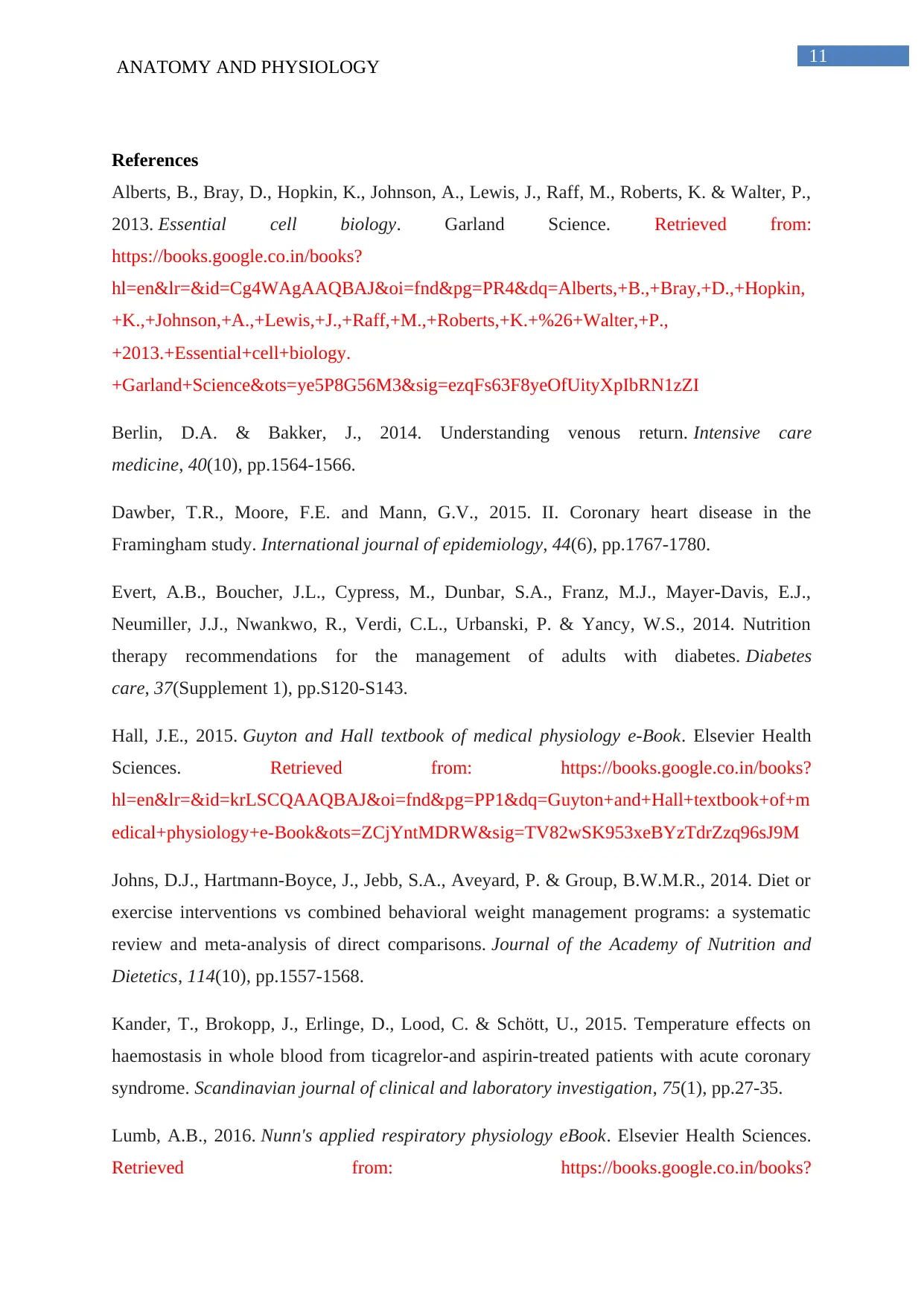
11
ANATOMY AND PHYSIOLOGY
References
Alberts, B., Bray, D., Hopkin, K., Johnson, A., Lewis, J., Raff, M., Roberts, K. & Walter, P.,
2013. Essential cell biology. Garland Science. Retrieved from:
https://books.google.co.in/books?
hl=en&lr=&id=Cg4WAgAAQBAJ&oi=fnd&pg=PR4&dq=Alberts,+B.,+Bray,+D.,+Hopkin,
+K.,+Johnson,+A.,+Lewis,+J.,+Raff,+M.,+Roberts,+K.+%26+Walter,+P.,
+2013.+Essential+cell+biology.
+Garland+Science&ots=ye5P8G56M3&sig=ezqFs63F8yeOfUityXpIbRN1zZI
Berlin, D.A. & Bakker, J., 2014. Understanding venous return. Intensive care
medicine, 40(10), pp.1564-1566.
Dawber, T.R., Moore, F.E. and Mann, G.V., 2015. II. Coronary heart disease in the
Framingham study. International journal of epidemiology, 44(6), pp.1767-1780.
Evert, A.B., Boucher, J.L., Cypress, M., Dunbar, S.A., Franz, M.J., Mayer-Davis, E.J.,
Neumiller, J.J., Nwankwo, R., Verdi, C.L., Urbanski, P. & Yancy, W.S., 2014. Nutrition
therapy recommendations for the management of adults with diabetes. Diabetes
care, 37(Supplement 1), pp.S120-S143.
Hall, J.E., 2015. Guyton and Hall textbook of medical physiology e-Book. Elsevier Health
Sciences. Retrieved from: https://books.google.co.in/books?
hl=en&lr=&id=krLSCQAAQBAJ&oi=fnd&pg=PP1&dq=Guyton+and+Hall+textbook+of+m
edical+physiology+e-Book&ots=ZCjYntMDRW&sig=TV82wSK953xeBYzTdrZzq96sJ9M
Johns, D.J., Hartmann-Boyce, J., Jebb, S.A., Aveyard, P. & Group, B.W.M.R., 2014. Diet or
exercise interventions vs combined behavioral weight management programs: a systematic
review and meta-analysis of direct comparisons. Journal of the Academy of Nutrition and
Dietetics, 114(10), pp.1557-1568.
Kander, T., Brokopp, J., Erlinge, D., Lood, C. & Schött, U., 2015. Temperature effects on
haemostasis in whole blood from ticagrelor-and aspirin-treated patients with acute coronary
syndrome. Scandinavian journal of clinical and laboratory investigation, 75(1), pp.27-35.
Lumb, A.B., 2016. Nunn's applied respiratory physiology eBook. Elsevier Health Sciences.
Retrieved from: https://books.google.co.in/books?
ANATOMY AND PHYSIOLOGY
References
Alberts, B., Bray, D., Hopkin, K., Johnson, A., Lewis, J., Raff, M., Roberts, K. & Walter, P.,
2013. Essential cell biology. Garland Science. Retrieved from:
https://books.google.co.in/books?
hl=en&lr=&id=Cg4WAgAAQBAJ&oi=fnd&pg=PR4&dq=Alberts,+B.,+Bray,+D.,+Hopkin,
+K.,+Johnson,+A.,+Lewis,+J.,+Raff,+M.,+Roberts,+K.+%26+Walter,+P.,
+2013.+Essential+cell+biology.
+Garland+Science&ots=ye5P8G56M3&sig=ezqFs63F8yeOfUityXpIbRN1zZI
Berlin, D.A. & Bakker, J., 2014. Understanding venous return. Intensive care
medicine, 40(10), pp.1564-1566.
Dawber, T.R., Moore, F.E. and Mann, G.V., 2015. II. Coronary heart disease in the
Framingham study. International journal of epidemiology, 44(6), pp.1767-1780.
Evert, A.B., Boucher, J.L., Cypress, M., Dunbar, S.A., Franz, M.J., Mayer-Davis, E.J.,
Neumiller, J.J., Nwankwo, R., Verdi, C.L., Urbanski, P. & Yancy, W.S., 2014. Nutrition
therapy recommendations for the management of adults with diabetes. Diabetes
care, 37(Supplement 1), pp.S120-S143.
Hall, J.E., 2015. Guyton and Hall textbook of medical physiology e-Book. Elsevier Health
Sciences. Retrieved from: https://books.google.co.in/books?
hl=en&lr=&id=krLSCQAAQBAJ&oi=fnd&pg=PP1&dq=Guyton+and+Hall+textbook+of+m
edical+physiology+e-Book&ots=ZCjYntMDRW&sig=TV82wSK953xeBYzTdrZzq96sJ9M
Johns, D.J., Hartmann-Boyce, J., Jebb, S.A., Aveyard, P. & Group, B.W.M.R., 2014. Diet or
exercise interventions vs combined behavioral weight management programs: a systematic
review and meta-analysis of direct comparisons. Journal of the Academy of Nutrition and
Dietetics, 114(10), pp.1557-1568.
Kander, T., Brokopp, J., Erlinge, D., Lood, C. & Schött, U., 2015. Temperature effects on
haemostasis in whole blood from ticagrelor-and aspirin-treated patients with acute coronary
syndrome. Scandinavian journal of clinical and laboratory investigation, 75(1), pp.27-35.
Lumb, A.B., 2016. Nunn's applied respiratory physiology eBook. Elsevier Health Sciences.
Retrieved from: https://books.google.co.in/books?
⊘ This is a preview!⊘
Do you want full access?
Subscribe today to unlock all pages.

Trusted by 1+ million students worldwide
1 out of 13
Related Documents
Your All-in-One AI-Powered Toolkit for Academic Success.
+13062052269
info@desklib.com
Available 24*7 on WhatsApp / Email
![[object Object]](/_next/static/media/star-bottom.7253800d.svg)
Unlock your academic potential
Copyright © 2020–2025 A2Z Services. All Rights Reserved. Developed and managed by ZUCOL.




